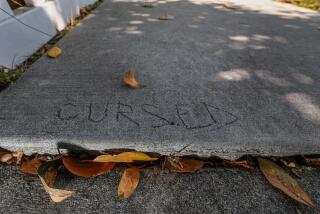Off the Wall : Erasing The Tagger’s Marks
The graffiti war is being waged on many fronts, from private organizations to the state Capitol.
The Epple bill, now in the Senate, takes ideas from a number of graffiti bills. The bill, AB 1179 by Assemblyman Bob Epple (D-Cerritos), provides a three-year prison sentence for taggers arrested three times and imposes stiff penalties for vandalizing public property.Taggers nabbed with chisels, drill bits and other tools used for etching could be fined $1,000 and sent to jail fr six months.
In Los Angeles, Operation Cleansweep last year distributed about 30,000 gallons of paint to local groups who beat back the graffiti tide weekly. Los Angeles Police Department officials estimate there are between 2,000 and 3,000 taggers in the San Fernando Valley.
Graffiti Removal Techniques Laser blaster: Laser beams can be used without damaging a structure like a sandblaster, but the equipment is bulky and could prove costly. Blasting: Removal using sand, water or baking soda Chemicals: Used to remove graffiti from utility boxes, light poles and other metal surfaces. Industrial coatings: Employed by the Metropolitan Transportation Authority to protect buses from graffiti. Sacrificial windows: A thin plastic film is placed over bus windows to prevent etching and painting. It can be removed easily and at $25 is a lot less costly than replacing bus windows, which cost about $400 each.
Government Strikes Back The city and county of Los Angeles and two transportation agencies expect to spend about $29 million this year to eradicate graffiti. The groups, along with law enforcement and a variety of community groups, have formed the Multi-Agency Graffiti Intervention Committee, or MAGIC, to share information on how to fight vandalism. A sampling of the efforts by MAGIC members in 1993: Los Angeles County Budget $800,000 Agenda: Board of Supervisors, which held a graffiti summit in March, expects to release a comprehensive report on anti-graffiti efforts in mid-September. Los Angeles Budget: $4.6 million Agenda: City Council recently passed an ordinance requiring merchants to lock marking pens and aerosol containers in display cases, accessible only to store employees. After a first warning, offenders will be prosecuted and face a fine of $1,000. The second measure, passed Aug. 13, imposes a $1,000 fine for anyone caught tagging public or private buildings. Metropolitan Transportation Authority Budget: $13 millions (has requested an additional $7 million for this year). Agenda: Under a new “zero-tolerance” program, buses are cleaned by convicted taggers. Caltrans Budget: About $3 million in Los Angeles and Ventura counties. Agenda: Paints over graffiti and works with community groups and LAPD to catch taggers.
Hotlines A Valley sampling: Neighborhood Beautification Hotline (Woodland Hills and Tarzana): 346-4082 Sylmar Graffiti Busters Hotline: 362-8702 MTA: Toll free number is expected sometime this fall. But until then (800) 78-CRIME or MTA Transit Police at (213) 972-6280. CALTRANS Graffiti Hotline: (213) 897-0380. Two Operation Cleansweep Hotlines in the Valley: For Granada Hills, Northridge, Pacoima, Van Nuys and North Hollywood, 375-1000; for Sun Valley, Tujunga, Sunland and Panorama City, 772-7553 LAPD’s Community Tagger Task Force Hotline: 989-8063
Misguided “Fame” “They (taggers) say it’s a source of recognition and fame. They like to be known among other taggers. . . But if they put it up and it’s gone the next day, there’s no fame.” Detective Craig Rhudy, LAPD, coordinator of Community Tagger Task Force
A Monumental Problem The amount of graffiti removed by Caltrans in Los Angeles and Ventura counties last year amounted to 7 million square feet. It estimates that 15 to 20 million square feet will be removed this year, which is enough to cover a wall measuring about a mile long and 3/4-mile high. 1993: 15 million sq. ft. 1992: 7 million sq. ft. Sources: State and local governments
More to Read
Sign up for Essential California
The most important California stories and recommendations in your inbox every morning.
You may occasionally receive promotional content from the Los Angeles Times.










